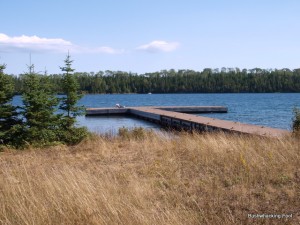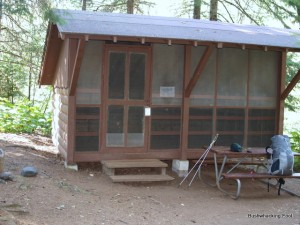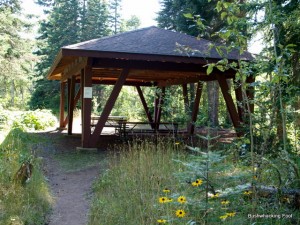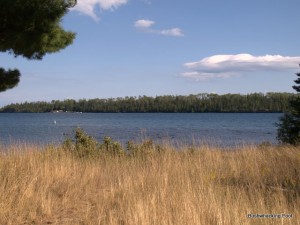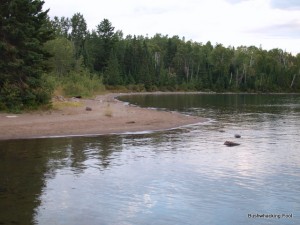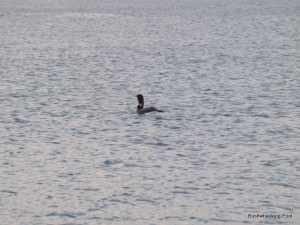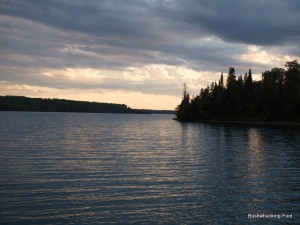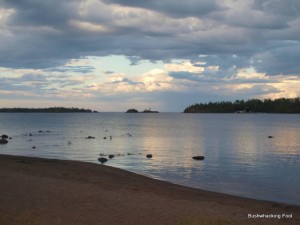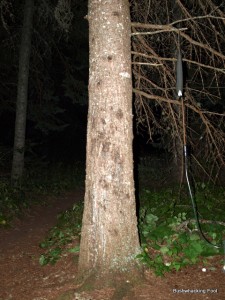The following is a description of a 19-day adventure to Isle Royale National Park. The trip includes driving more than 900 miles to Copper Harbor and back, a ferry over the rough water of Lake Superior and two weeks of hiking to one end of the 45-mile long island and back. Part four of the first day is about my evening at Daisy Farm Campground.
Section Stats:
Date: August 29, 2011
Length: 0 miles (8.2 total miles)
Difficulty: Easy
An empty Daisy Farm clearing stands before me under a clear blue sky, a dramatic contrast to the busier and overcast conditions I left behind at Rock Harbor. After hiking along Rock Harbor all afternoon, I find myself at my final destination for the day, and it is only a little after 4:30 PM.
A grassy field is the centerpiece of Daisy Farm. The knee-high grass stands brittle and brown from a dry summer, while many young aspens along the clearing edge appear to be slowly invading the clearing. Along the edges of the clearing stand a few medium-sized spruce trees, while larger trees tower over them farther back into the surrounding forest.
Several deep ruts spread out from the dock in Rock Harbor, all heading out in different directions. While one leads to a ranger’s cabin, two others head for the Greenstone Ridge. Side trails located back in the forest spread out from the main trails, winding through the trees to each of the different shelters and tenting sites.
I peruse the announcements at the Daisy Farm kiosk, reading general announcements or outdated notices about different talks from earlier in the summer behind a locked plexi-glass façade. Given the late hour, I try not to linger too long; even though there is little chance at securing a shelter for myself this late in the afternoon. I take a brief moment to study the layout of the campgrounds, and then head off in search of an empty shelter.
When I find the second shelter on my rounds empty, surprise and relief overwhelm me, as does a sudden exhaustion. Apparently, the exhilaration of finally being on the island had kept the tiredness at bay for much of my day’s hike. Rather than continue on, I hang my permit on the door handle for the shelter at campsite #5.
Along with the shelter, my new home comes with a full-size picnic table. Although primitive by most standards, these accommodations are luxurious in comparison to my typical bushwhacking campsites. Sitting on the picnic table is a welcome, albeit short, respite from the aggressive pace along the Rock Harbor Trail on my way to Daisy Farm.
Just a quick look around the shelter and a possible reason for its vacancy becomes apparent. Behind the shelter is a small, almost dry stream. The slimy, black and damp rocks suggest a free-flowing stream during more moist times, as does the bordering succulent vegetation and dense shrubbery. Luckily, the screened shelter should offer ample protection from any mosquitoes that might emerge during the evening time.
The shelter is quite large; they easily sleep 6 adults. Unlike their namesake, these Adirondack shelters are constructed with modern boards, not the logs frequently used on Adirondack lean-tos. Despite their greater height, I find myself stooping unnecessarily while inside, a stubborn lesson learned after more than a few blows to the head over the years.
Inside is a multitude of graffiti covering the walls, much of it apparently done in ink. The graffiti ranges from simple names and initials, to perverse illustrations of grotesquely out of proportion parts of the human anatomy. It appears these themes are universal, similar images can be found from Adirondack lean-tos to cave-drawings of Lascaux, France.
The metal screen covering the entire front of the shelter is a welcome addition. No elaborate setup of my mesh Golite Nest is necessary now. Although the shelter’s screen is not nearly fine enough to keep out no-see-ums, there is little doubt it will be more than a match for mosquitoes and black flies. The many patches indicate the National Park Service is serious about protecting the sanctity of their shelters.
After taking a momentary respite to check out my evening digs, I quickly begin setting up my camp. Heeding the many warnings of pilfering wildlife, I place most of my equipment within the shelter, taking care not to slam the spring-loaded door. The inexpensive blue closed-foam sleeping pad, my Therm-a-Rest ProLite and my Western Mountaineering Highlite sleeping bag are strewn out along shelter’s side wall; staking my claim furthest away from the door just in case it becomes necessary to share.
My water supply nearly exhausted, I pull myself away from setting up my campsite to more immediate matters. A quick search inside the Pinnacle backpack yields the re-sealable plastic bag holding my inline water filter and related gear. With the Platypus Big Zip Reservoir and the Backpacker’s Pantry collapsible pack bowl in hand, I set off for the shoreline to obtain some water from Rock Harbor.
The most direct route back to the dock is through another shelter just immediately to the east of my own. Not wanting to disturb the other people at that site, I head southwest on a short trail that skirts the edge of a large picnic pavilion, fully outfitted with a couple picnic tables, to the Daisy Farm Trail. Only a short walk to the south along this trail brings me back to the open area and the large dock.
The Daisy Farm dock is very large, like a huge “T” jutting out into Rock Harbor. The dock is made of a very hard substance, resembling pavement but with a pinkish hue. Despite the hard surface, a single man lies on his back, one leg bent at the knee, the other leg crossed over the bent one. Obviously, he is resting after a hard, long day on the trail.
I can relate to the necessity of a long respite, especially in such a tranquil area as along the shore of Rock Harbor. Unfortunately, there are many tasks left to do this day and no one else to do them other than myself. Such is the burden of the solo hiker.
I walk out on the dock to get a feel for the area. The sky remains mostly clear, while a steady but light breeze makes near constant small waves along the waters of Rock Harbor.
Across the water there are several boats, apparently anchored off the opposite shore. Near them are what appear to be several vertical lime-green windmills. I can see them spinning through my compact binoculars but cannot discern their purpose; too bad I was not carrying my full-sized Leica Ultravid 8×42 or my Eagleoptics Ranger 8×35 binoculars. According to my map, the Historic Edisen Fishery and a small cemetery lie in the same general location, along with a dock and a short trail.
While scanning the scenery from the dock, I spot two bald eagles flying overhead. Although high in the sky, my binoculars reveal them to be two adults, perhaps a mated pair. They circle overhead repeatedly, and continue to do so even as I exit the dock several minutes later.
I leap off the dock at the shoreline and seek out a rock to step out into the water on and fill my reservoir. Short on water and starving from a day without any lunch, I try not to dawdle too much. After filling both the reservoir and my collapsible bowl, I head back to my shelter to filter water and get about making my dinner and satisfying the gnawing hunger within the pit of my stomach.
Upon returning to my shelter, I set up my inline water filtering system, and let gravity do its job while I do something about my yearning hunger. I fumble through the bulging, black Silnet stuff sack, trying to locate the dinner weighing the most for the night’s meal. Finally, I settle on a packet of Salmon
, mixed in with some instant rice and freeze-dried corn; a hearty meal for a long, first day.
While cooking my dinner out on the picnic table, the sky clouds over and a foreshadowing darkness engulfs the forest interior and edge alike. A few rain drops fall on the lid of my pan, quickly evaporating but sending me into a flurry of activity, throwing almost everything into the shelter to keep dry. Nothing comes of the few drops though; by the time my dinner is ready the sky is already lighter, with several patches of blue sky reappearing amongst the clouds.
While eating, a dinner guest joins me, apparently hoping for a handout. The red squirrel runs across my campsite, making a bee-line for the picnic table, where it leaps onto the top of the picnic table with ease. The little, dark eyes stare into mine as it looks up at me with a seemingly sad, expectant gaze. Between the DuFresne book and the orientation back at Rock Harbor, warnings about the thievery ways of red squirrels, red foxes and other nefarious wildlife on Isle Royale has been drilled into my head. After engaging in a stare down with the little rodent for a while, I shoo it away before it gets even more aggressive. It runs off, scolding me for my lack of generosity, or stupidity.
Familiar bird calls are common during my meal. A murder of American crows flies overhead, cawing the entire time. A white-throated sparrow performs its typical “Oh sweet Canada, Canada, Canada” song, something I thought I would not hear again this summer. Red-breasted nuthatch, common flicker, pileated woodpecker and blue jay are a few other birds I hear calling while at my campsite.
After cleaning up from dinner and securing my equipment and food in the shelter, I begin gathering up my camera, binoculars
and note-taking materials for a short trip down to the dock while the daylight holds out. While getting my gear together in the shelter, the red squirrel returns, searching the top of my picnic table for any tasty morsels left behind. Too bad I am thorough diner and it returns to knocking spruce cones out a nearby tree.
My brilliant idea of spending some time on the dock appears not to be unique based on the other people on the dock. Luckily, one end of the dock remains uninhabited, so I settle down to alternate between catching up on my note taking and viewing the outstanding scenery.
Before even getting comfortable, a common loon comes in closely, apparently curious about my activities. It flaps its wings repeatedly after it approaches my position on the dock. I watch for further signs of agitation, and only after several minutes does it dawn on me to take some photographs of the bird’s active behavior. When I finally get my Olympus E-420 camera out and ready to go, the loon has wised up and returns to just swimming around. It must be camera shy.
Cloud cover moves back in during my time out on the Daisy Farm dock. I take numerous pictures, mostly concentrating on a couple islands toward the Middle Islands Passage to the east, as well as southwest into Moskey Basin. The sunlight out of the west striking some of the fluffy, dark clouds, visible only through breaks in the clouds make for some stunning sights. Too bad my novice camera skills never do these sights justice.
When the setting sun ceases to provide enough light to continue note writing, I retire from the dock and return to my campsite for the night.
As I pass along the pavilion, I notice some activity out of the corner of my eye. When I turn in the direction of the activity, I fail to see anything. After spending some time looking about, I finally determine the source of the activity. Numerous bats are flying about; circling around and around the pavilion in a very regular pattern.
This proves to be quite a thrill. On my previous trip to Oven Lake and surrounding ponds in the Adirondacks’ Five Ponds Wilderness, I failed to see a single bat. Eastern bat populations were decimated by the white-nose syndrome, sometimes killing up to 90% of the bat populations in many areas. Obviously, the disease has yet to spread to the north-central United States, and may it stay that way.
I stand still watching the bats fly about me for a long while; it was nearly totally dark before I return the short distance to my shelter. While at the shelter, the bats are still flying about there too. Some of them are even quite large, thus I suspect at least two different species were present.
The thought of trying to capture one with my camera dawns on me, so I set the camera for dim-light conditions and orient myself toward a nearby spruce tree. At regular intervals, I snap a picture of the tree, hoping to also capture a bat as it flies by. This tactic proves ultimately unsuccessful, although it does rouse one of the other campers out of the shelter in front of me, apparently to see what the heck I am doing. Wanting to avoid irritating them any further, I finally surrender and admit defeat.
With total darkness descending on the surrounding forest, I succumb to my heavy eyelids and crawl into my sleeping bag for the night. It is hard to believe I woke this morning in Copper Harbor, ferried across Lake Superior to Isle Royale and then hiked over 8 miles to Daisy Farm in single day. I drift off to sleep thinking about my plan for tomorrow to climb up and along the Greenstone Ridge before descending over to McCargoe Cove for tomorrow night.
Affiliate Disclaimer: Some links within this blog post may send you to a retailer website. If you chose to purchase any product at that site at that time the author will receive a small commission. These commissions provide compensation for the author’s time and effort necessary to provide the content at the Bushwhacking Fool.

